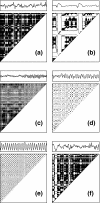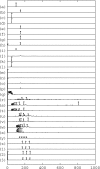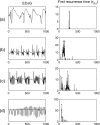Detection of seizure rhythmicity by recurrences
- PMID: 19045462
- PMCID: PMC2688817
- DOI: 10.1063/1.2973817
Detection of seizure rhythmicity by recurrences
Abstract
Epileptic seizures show a certain degree of rhythmicity, a feature of heuristic and practical interest. In this paper, we introduce a simple model of this type of behavior, and suggest a measure for detecting and quantifying it. To evaluate our method, we develop a set of test segments that incorporate rhythmicity features, and present results from the application of this measure to test segments. We then analyze electrocorticogram segments containing seizures, and present two examples. Finally, we discuss the similarity of our method to techniques for detecting unstable periodic orbits in chaotic time series.
(c) 2008 American Institute of Physics.
Figures








Similar articles
-
A paradigm for epileptic seizure prediction using a coupled oscillator model of the brain.Annu Int Conf IEEE Eng Med Biol Soc. 2009;2009:6428-31. doi: 10.1109/IEMBS.2009.5333792. Annu Int Conf IEEE Eng Med Biol Soc. 2009. PMID: 19964425
-
Detection of spectral instability in EEG recordings during the preictal period.J Neural Eng. 2007 Sep;4(3):173-8. doi: 10.1088/1741-2560/4/3/001. Epub 2007 Apr 4. J Neural Eng. 2007. PMID: 17873418
-
Dynamical resetting of the human brain at epileptic seizures: application of nonlinear dynamics and global optimization techniques.IEEE Trans Biomed Eng. 2004 Mar;51(3):493-506. doi: 10.1109/TBME.2003.821013. IEEE Trans Biomed Eng. 2004. PMID: 15000380
-
Recording and analysis techniques for high-frequency oscillations.Prog Neurobiol. 2012 Sep;98(3):265-78. doi: 10.1016/j.pneurobio.2012.02.006. Epub 2012 Mar 7. Prog Neurobiol. 2012. PMID: 22420981 Free PMC article. Review.
-
Epileptic seizure prediction and control.IEEE Trans Biomed Eng. 2003 May;50(5):549-58. doi: 10.1109/tbme.2003.810705. IEEE Trans Biomed Eng. 2003. PMID: 12769431 Review.
Cited by
-
Does hyperbaric oxygen cause narcosis or hyperexcitability? A quantitative EEG analysis.Physiol Rep. 2022 Jul;10(14):e15386. doi: 10.14814/phy2.15386. Physiol Rep. 2022. PMID: 35859332 Free PMC article.
References
-
- Theiler J., Eubank S., Longtin A., Galdrikian B., and Farmer J. D., Physica D PDNPDT10.1016/0167-2789(92)90102-S 58, 77 (1992). - DOI
-
- Eckmann J. P., Kamphorst S. O., and Ruelle D., Europhys. Lett. EULEEJ10.1209/0295-5075/4/9/004 4, 973 (1987). - DOI
-
- Casdagli M. C., Physica D PDNPDT10.1016/S0167-2789(97)00030-4 108, 12 (1997). - DOI
-
- Gao J. B., Phys. Rev. Lett. PRLTAO10.1103/PhysRevLett.83.3178 83, 3178 (1999). - DOI

